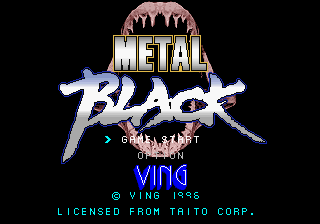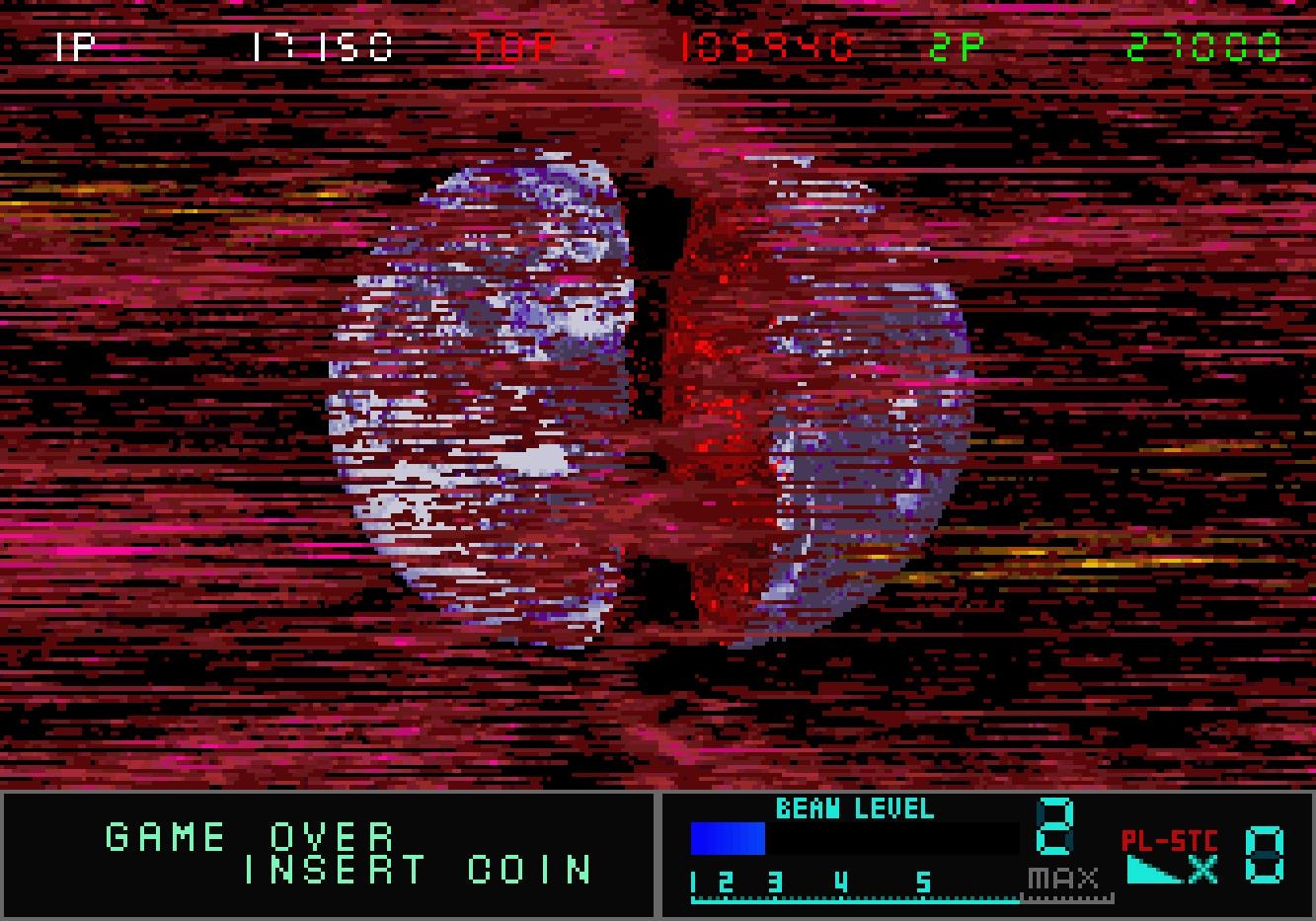Metal Black
From Sega Retro
| Metal Black | |||||||||||||||
|---|---|---|---|---|---|---|---|---|---|---|---|---|---|---|---|
| System(s): Sega Saturn | |||||||||||||||
| Publisher: Ving | |||||||||||||||
| Developer: Ving | |||||||||||||||
| Licensor: Taito | |||||||||||||||
| Original system(s): Taito F2 System | |||||||||||||||
| Sound driver: SCSP/CD-DA (21 tracks) | |||||||||||||||
| Genre: Shooting[1][2] | |||||||||||||||
| Number of players: 1-2 | |||||||||||||||
| |||||||||||||||
|
Metal Black (メタルブラック) is a Sega Saturn horizontal shoot-'em-up developed and published by Ving. A port of the titular 1991 Taito arcade game Metal Black, it was released exclusively in Japan in May 1996, and later received a Satakore budget label re-release in July 1998.
Contents
Story
In the future, earth is attacked by aliens that possess the ability to harness the power of "Newalone", a strange, molecule like structure. Earth counters by buidling it's own fleet also based on "Newalone" technology, but freezes the project on favour of peace with the alien. The contract is very oneside and earth is dying. A single solider breaks into a military complex and manages to steal a "Black Fly", a space ship designed to use "Newalone"
Gameplay
In typical shooting game manner, Metal Black uses a two button setup, with one being used for standard shots, and the onther one for beam attacks. Both attacks can be powered up by collecting Newalone, which floats around freely in stages. The beam weapon becomes a screen covering burst attack when the maximum amount of Newalone has been collected. The Burst can be refocused to a beam by holding down the beam button.
Bosses also use beam attacks, and one can duel with the bosses by countering with a beam attack. The outcome of these duels depends on the accumulated Newalone.
Two special stages exist where one has to lock onto enemies in a pseudo 3D space and fire missiles. The random nature of these stages, combined with the fact that score largely depends on fast lockons, has been the target of criticism.
An alternative ending can be viewed by dying and not continuing on the last stage.
History
The game is also titled Project Gun Frontier 2, although there are no connections to Gun Frontier content wise. Allegedly content from a canceled Darius sequel was also reused for this game, supported by fish and crustecan enemies found in the game. The beam mechanic was also used in G Darius, which was not released on Sega hardware
The game was a major inspiration for Border Down; both that game and Metal Black share a composer.
Versions
Aside from unavoidable load times introduced by the compact disc format, Metal Black is otherwise a perfect port of the original arcade release.
Production credits
- Producer: Senba Takatsuna, Hori Takamasa
- Game Design: Senba Takatsuna, Hori Takamasa, Kuroki Naoya, Ohno Tomohiro, Seguchi Takashi, Mizobe Kumi, Watanabe Yasuhisa, Sawaki Jun, Katsuhisa Ishikawa
- Thanks: Kimura Chiho, Taniyama Norihito, Miyazawa Takayuki
- Art Director: Senba Takatsuna, Ohno Wepokichi
- Programmer: Tarabar, Kuroki Naoya, Seguchi Takashi
- Hardware Engineer: Sawaki Jun, Takeda Tomio
- Decorator: Mizobe Kumi
- Sound Director: Yack. (Zuntata), Babio Ishikawa (Zuntata)
- Bit Pattern: Moriyama Yoshihiro, Tanaka Kuniaki, Yoshikatsu Nakahara, Tsuneoka Masatoshi, Vap-Awave
- Cast: Ho Lee Chan, Zuntata, John Neianik 6Th, Sakou Menme
- Special Thanks: 3D Master, Mar., Karu, Wiz. Master, Nomura Akio, Mihara Hiromitsu, Tajima Kazunari, Fujita Tsukasa$, Zak Munn, Kouno Yoshiaki, Ogata Masaki, Fujisue Ichirou, Fujiwara Hidehito, Sakou Hiroyuki, Yagi Chan, Yoshida Sayuri, Sekiguchi Satomi, Shirou Imaoka, Yuki Hisao, Shimizu Shigenobu, Ohishi Kenji, Shimizu Fumihiko, Shintaku Satoyuki, Naomitsu Abe, Ishii Hide, Ushiroda Tatsuya, Yasukouchi Daisuke, Kurabayashi Akira, Takaaki Tomita, Nakamura Taicho, Ootsuki Akira, Sugiyama Kazuhiko, Default Members
Magazine articles
- Main article: Metal Black/Magazine articles.
Promotional material
Physical scans
| Sega Retro Average | |||||||||||||||||||||||||||||||||||||||||||||||||||||||||||
|---|---|---|---|---|---|---|---|---|---|---|---|---|---|---|---|---|---|---|---|---|---|---|---|---|---|---|---|---|---|---|---|---|---|---|---|---|---|---|---|---|---|---|---|---|---|---|---|---|---|---|---|---|---|---|---|---|---|---|---|
|
| 61 | |
|---|---|
| Based on 11 reviews | |
| Saturn, JP (Satakore) |
|---|
Technical information
- Main article: Metal Black/Technical information.
References
- ↑ File:MetalBlack Saturn JP Box Back.jpg
- ↑ 2.0 2.1 https://sega.jp/fb/segahard/ss/soft_licensee2.html (Wayback Machine: 2020-03-20 23:05)
- ↑ Sega Saturn Magazine, "1996-05 (1996-03-22)" (JP; 1996-03-08), page 27
- ↑ File:MetalBlack_Saturn_JP_SSEnding.pdf
- ↑ Famitsu, "1996-05-31" (JP; 1996-05-17), page 1
- ↑ Fun Generation, "08/96" (DE; 1996-07-10), page 79
- ↑ Intelligent Gamer, "August 1996" (US; 1996-0x-xx), page 85
- ↑ Joypad, "Juillet/Août 1996" (FR; 1996-0x-xx), page 72
- ↑ MAN!AC, "09/96" (DE; 1996-08-14), page 48
- ↑ Mega Force, "Été 1996" (FR; 1996-0x-xx), page 79
- ↑ neXt Level, "August 1996" (DE; 1996-07-10), page 64
- ↑ Playmag, "Juillet/Août 1996" (FR; 1996-0x-xx), page 128
- ↑ Saturn Fan, "1996 No. 15" (JP; 1996-07-05), page 81
- ↑ Sega Saturn Magazine, "1996-09 (1996-06-14)" (JP; 1996-05-24), page 231
- ↑ Sega Saturn Magazine, "Readers rating final data" (JP; 2000-03), page 11
| Metal Black | |
|---|---|
|
Main page | Comparisons | Hidden content | Development | Magazine articles | Reception | Technical information | |











